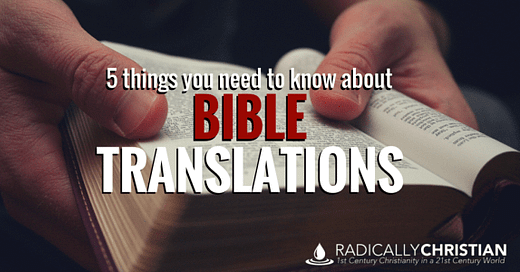5 Things You Need to Know About Bible Translations
Most of the English speaking world has no idea how blessed we are to have so many English translations of the Bible. There was a time when making an English translation of the Bible was illegal and there are many places around the globe where people would do anything to have a copy of the Bible in their native tongue. But with various English translations of the Bible, there are some things we need to understand.

At the risk over simplifying this matter, here are five things I think Christians need to know and understand about Bible translations:
1. We Do Not Have the Original Manuscripts
You probably already know this, but the Bible is comprised of 66 books and these books were written in Hebrew, Aramaic, and Greek by about 40 different inspired men, “as they were carried along by the Holy Spirit” (2 Peter 1:21). Because they were written thousands of years ago, the original handwritten manuscripts have long since deteriorated and turned to dust.
But before they disappeared, they were meticulously copied by thousands of scribes over thousands of years. Many of these scribes were not translating the Scriptures into a different language; they were simply making fresh copies (sort of like an ancient form of Xerox) to faithfully preserve God’s word. We have thousands of these manuscripts in the languages in which they were originally written.
There are understandably some variations and discrepancies between these thousands of manuscripts, some manuscripts are older than others, and some manuscripts are considered more reliable than others. But because most of the scribes were very meticulous, there are relatively few variations and when all the manuscripts are compared to one another, we can be confident we know what the inspired authors originally wrote.
Understanding this helps us to understand that the more manuscripts we discover, and the more we learn about the original languages, the more accurate our translations become. Some people are hesitant to trust newer translations. I understand that, but I think we need to recognize that we have far more information now than people had in 1611, for instance, when the King James Version was first published. Therefore, in some ways, some of the newer translations are superior.
2. Translators Have Different Philosophies
In addition to the manuscripts used, translations vary based on the publishers’ philosophies and principles of translation. In the front of most Bibles you can usually find a page explaining the translation philosophy. I can’t overemphasize how important it is for you to pay attention to this page in your Bible.
One difference in translation philosophy is word-for-word vs. thought-for-thought. You see, translation is not always an exact science. There is not always an exact English equivalent for every Greek, Hebrew, or Aramaic word. Furthermore, the inspired authors often used idioms that made perfect sense to the original audience, but would not mean the same thing to us if translated word-for-word.
Consider our idiom, “It’s raining cats and dogs.” English readers understand that phrase, but if it were translated word-for-word into another language, people might look to the sky for falling canines and felines. So if you translated that phrase as, “It’s raining really hard,” that would be a far more useful translation than a literal word-for-word translation.
So there are times when translations are more useful when they translate thought-for-thought, rather than word-for-word. However, I believe this is the exception, rather than the rule. If translators go too far in this direction they can easily start telling readers what they believe the text means, rather than what the text says. Which is why I favor translations that lean more toward a word-for-word philosophy and I steer away from the thought-for-thought translations.
Here is a chart that I found online many years ago that I find very helpful. I tend to favor the translations on the left side of this graph, like the New American Standard (NASB) and the English Standard Version (ESV).

But the important thing is that YOU research your version’s translation philosophy and understand whether your translation is telling you what the text says or telling you what they believe the text means.
3. English Words are Always Changing Meaning
Another element to consider is the changing meanings of English words. For example, consider how the word “gay” has changed over the years. In the King James Version, James 2:3 says, “gay clothing,” but the New American Standard says, “fine clothes.” The word “gay” means something completely different today than it did when the King James Version was translated.
Because our English language is constantly changing, we will ALWAYS need new translations that help the text to maintain the correct meaning in the current vernacular. One hundred years from now, if the Lord hasn’t come back, we will need new translations because the English language will have changed.
4. Theologically Significant Words Shouldn’t be Abandoned
While there is something to be said for translating the Bible so it can be understood, we must be very careful not to abandon theologically significant words and phrases simply because many people don’t know what they mean. Words like propitiation, sanctification, atonement, justification, and redemption might not be heard in everyday language, but that doesn’t mean they need to be abandoned for more culturally relevant words.
In an effort to make the Bible more readable, many modern translations (especially the versions on the right side of the chart above), tend to jettison these words. In so doing, they no longer communicate the depth and beauty of the gospel message. And in some cases, they have actually distorted and perverted the gospel message.
We need to elevate our own understanding to the level of Scripture, rather than asking Scripture to be brought down to our level. If we don’t understand what words like “propitiation” mean, we need to do some research and study rather than throwing away important gospel words.
5. Using Multiple Translations is a Great Idea
I believe Christians are making a huge mistake when they limit themselves to one translation. You will have a much more comprehensive knowledge of God’s word if you compare, and read from, various translations. So here are a few personal recommendations:
For your primary Bible – the Bible you use for Bible classes, worship services, and personal Bible study – I recommend a more literal “word-for-word” translation.
But when you’re just reading the Bible to get the “big picture,” you might want to occasionally use a “thought-for-thought” translation so you can more easily understand the narrative aspect of Scripture.
Anytime you are studying, and especially when you don’t understand a passage, it’s a good idea to compare translations. And rather than having four or five Bible open when you study, you can use a parallel Bible or a website like BibleGateway.com to easily compare the same passage in various translations.
Paraphrase versions are not evil, but if you use a paraphrase version, I recommend using it not like a Bible, but like a commentary.
I hope this gives you a few things to think about when you are considering which translation of the Bible to use.
And may I also suggest we be kind, patient, and gracious when people decide to use a different translation than we use? If you use the KJV, awesome! If you prefer a newer translation, that’s great! Just make sure you know why you are using that Bible, don’t be afraid to compare translations from time and time, and “above all, keep loving one another earnestly” (1 Peter 4:8).
I love you and God loves you,
Wes McAdams
The post 5 Things You Need to Know About Bible Translations appeared first on Radically Christian.




